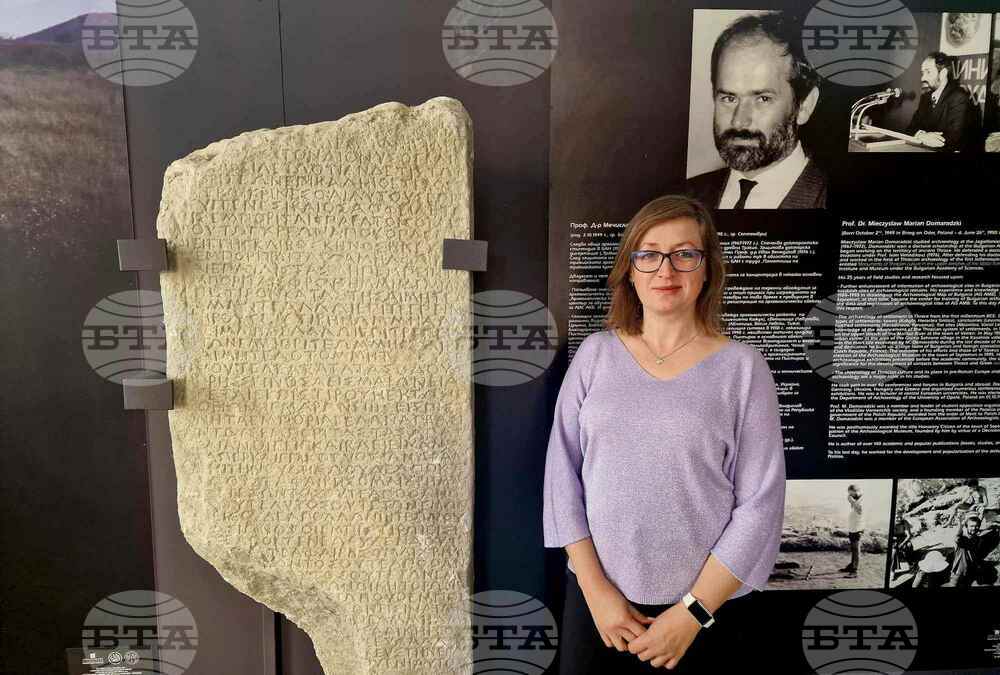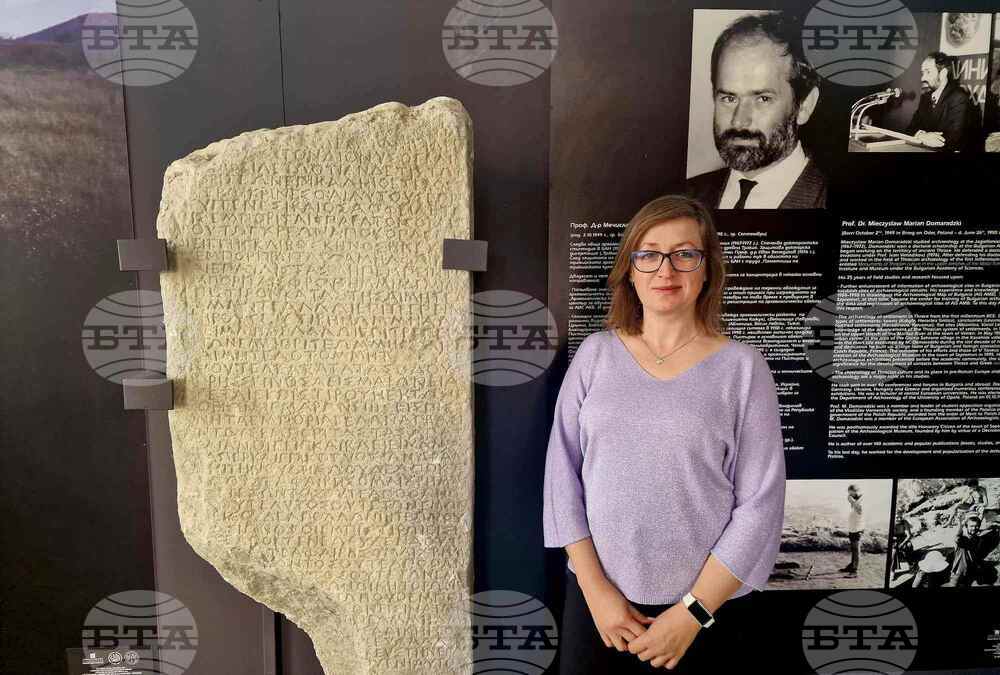site.btaUPDATED Pistiros Inscription to Be Exhibited in J. Paul Getty Museum in Los Angeles


The inscription from Pistiros, also known as the Vetren inscription, from the collection of the Archaeological Museum Prof. Mieczyslaw Domaradzki in the town of Septemvri is among the exhibits of fourteen Bulgarian museums, which will be on display at the J. Paul Getty Museum in Los Angeles, USA, between November 3, 2024, and March 3, 2025.
Excavations near the town of Vetren, Southern Bulgaria, began in 1988 on the left bank of the Maritsa River. They led to the discovery of a large commercial centre, the emporium Pistiros, which used to play a huge role in the economic and cultural life of ancient Thrace. The name of the emporium became known thanks to an inscription in Ancient Greek, the Pistiros Inscription, which was discovered in 1990.
Archaeological finds point to Pistiros having been founded during the time of the first kings of the Odrysian kingdom of Thrace - Teres or Sitalkes. By the time of Amadocus I the emporium was already thriving, having established trade contacts. Under Kotys I (4th century BC) and his successors, the merchants from Thasos, Apollonia and Maroneia guarantees for the inviolability of their lives, property and activities, as reflected in the Vetren inscription. This coincides with Pistiros's period of greatest prosperity.
Violeta Duneva, director of the Archaeological Museum Prof. Mieczyslaw Domaradzki, spoke with BTA about the Vetren inscription.
"First, let me clarify the main things about the exhibit - an inscription in Ancient Greek that is 44 lines long. We were able to weigh it during transportation - just over 500 kilograms. It was a challenge to get it packed and ready for the road, because each exhibit was shipped through Vienna to the United States. It is made of granite, like much of the fortress wall of Pistiros," Duneva shared.
The inscription was deciphered in 1990 by Prof. Velizar Velkov and Lidia Domaradzka, the wife of Mieczyslaw Domaradzki and a member of the team that explored Pistiros.
This inscription reveals that the region was chosen for the settlement, as it is close both to a mountain and a river. The locals used to trade with merchants from Thasos, Apollonia and Maroneia.
The slab has already been on display in the Louvre in 2015 as part of an exhibition entitled The Saga of the Thracian Kings: Archaeological Discoveries in Bulgaria. Seventeen Bulgarian museums also provided 30 Thracian coins demonstrating the toreutics and metalworking of the Thracian world as well as the ethnic composition of the Emporites.
A major exhibition on the Thracians at the Getty Museum in Los Angeles
Duneva shared: "We knew we were going to participate, and we were waiting for the moment to come. We were all excited when it was time to prepare. The exhibition will be interesting, because it will present not what we already know, such as the gold and silver treasures, but it will also show what the Thracians were like, their daily life, lifestyle, culture, how they established their trade contacts. Each of these 14 participating museums in Bulgaria will contribute to the overall presentation of the theme.
Early museum work in the town of Septemvri
The beginning of museum work in Septemvri dates back to the 1980s when a general historical museum collection was established and a curator was appointed to collect materials and work towards the development of a museum exhibition. The museum collection, officially unveiled in 1987, featured mainly ethnographic objects as well as artefacts related to railway operations and the September Uprising [a 1923 communist insurgency in Bulgaria].
Later in 1987, a previously unknown archaeological site was discovered near the village of Septemvri, Adzhiyska Vodenitsa, Septemvri Municipality. Its name, Pistiros, and its type, an emporium (trading post) founded by Greek settlers from the Aegean coast, were soon confirmed.
In 1988, Polish archaeologist Mieczyslaw Domaradzki became the head of regular archaeological excavations at Pistiros. The research was very fruitful, with all new finds getting added to the already existing collection. The first archaeological exhibition was presented in 1992. The expansion of the museum collection with objects of high scientific value, some of them unique for Bulgaria and Europe, led to a change in the museum's status to specialized archaeological museum in 1995. To this day, this is the only one on the territory of Pazardzhik Region.
In 1992, archaeologists from the University of Liverpool, UK, under the supervision of Dr Zofia Archibald joined the excavations. A year later, they were joined by a team led by Prof. Jan Bouzek of Charles University in Prague. In March 1988, surveys began at the Adzhiyska Vodenitsa led by Mieczyslaw Domaradzki of the National Archaeological Institute with Museum at the Bulgarian Academy of Sciences. The work continued with some interruptions until 2007. In 1998, Septemvri hosted an international symposium entitled Pistiros and Thasos: Trade Structures on the Balkan Peninsula in the V-II centuries BC. During the forum, the first permanent archaeological exposition was opened.
In 2005, the museum had to be moved to a new building. That year also marked the museum's 10th anniversary. To mark the occasion, the institution was renamed after Prof. Mieczyslaw Domaradzki, who was the first head of research at Pistiros and kept this position until his death in 1998. The Polish scholar was also named an honorary citizen of Septemvri Municipality. In June 2014 the new permanent exhibition Emporium Pistiros was opened with the financial support of the America for Bulgaria Foundation.
The Archaeological Museum Prof. Mieczyslaw Domaradzki in Septemvri is one of the newest museums in Bulgaria and the only specialized museum for archaeology in the territory of Pazardzhik Region. The museum promotes its research by organizing and participating in scientific forums, publications and exhibitions.
The museum's biggest attractions are the inscription from Pistiros and a collection of more than 1,500 coins depicting Thracian rulers. Duneva was hopeful that her museum's collection of Thracian coins, one of the largest in the world, would get even more people to visit.
Fourteen museums from Bulgaria with a total of over 150 objects will participate in a forthcoming exhibition of Thracian treasures at the J. Paul Getty Museum. Bulgarian artefacts represent more than 90% of all exhibits included in the exhibition.
/NZ/
news.modal.header
news.modal.text